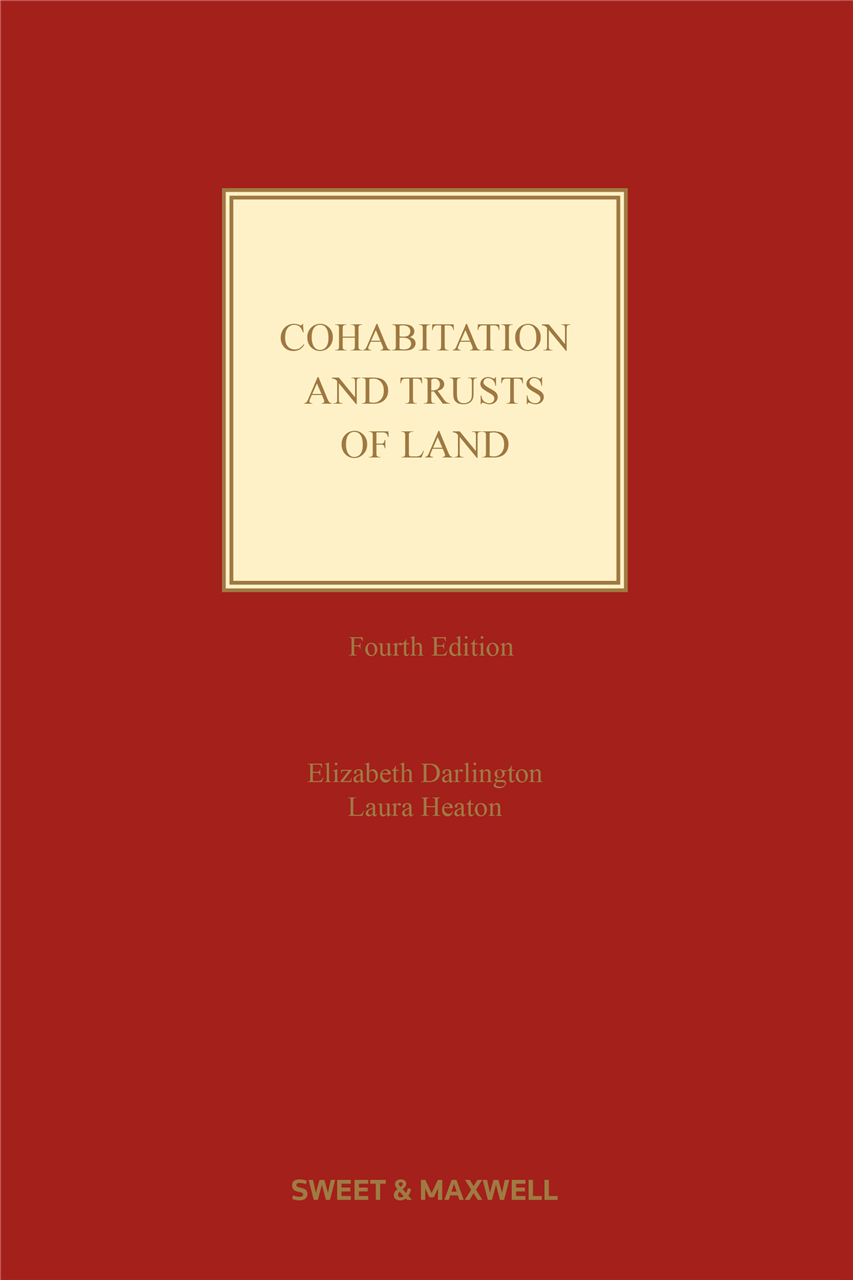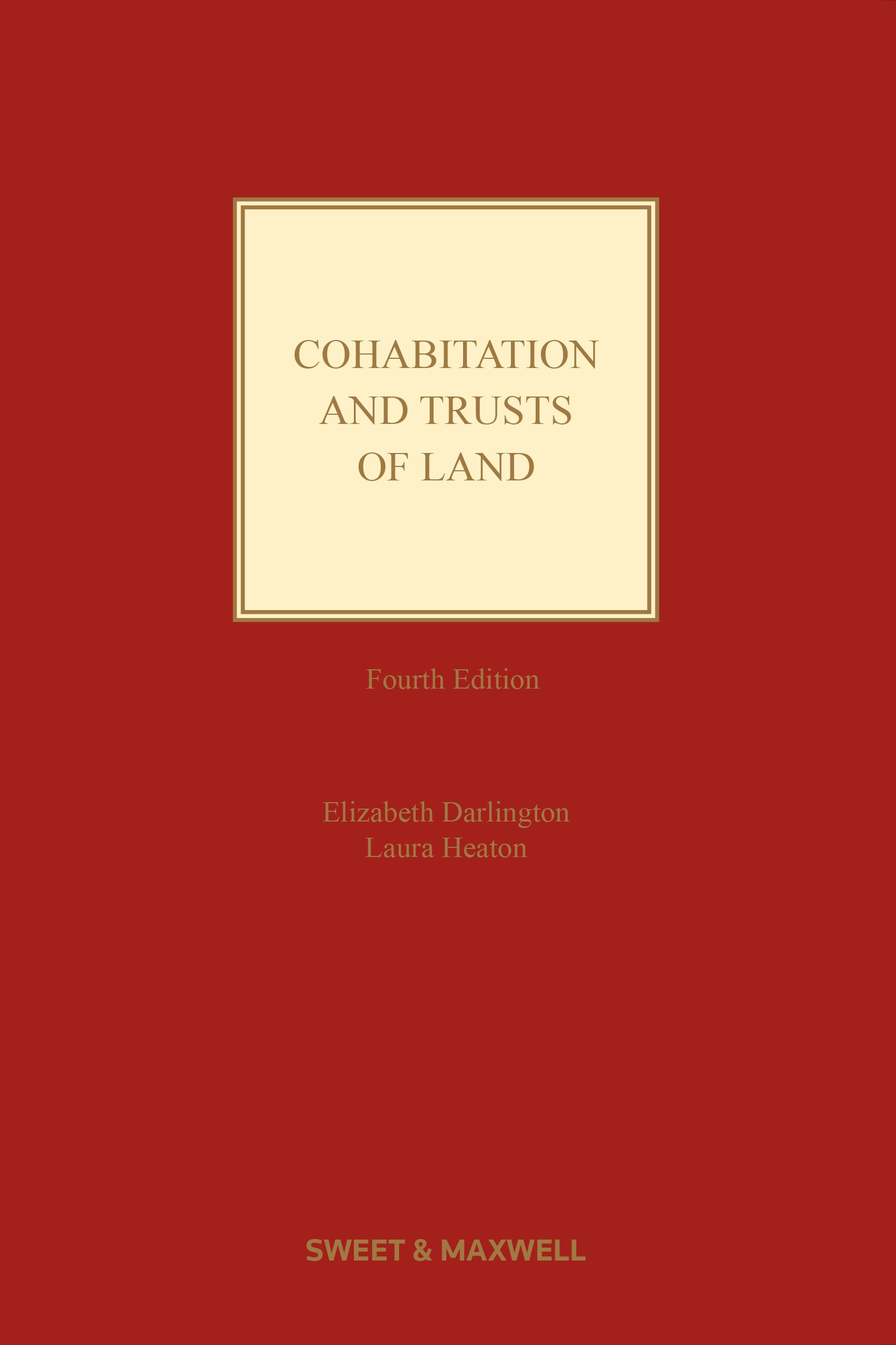
Book Review: Cohabitation and Trusts of Land
Published: 13/03/2024 07:00

Elizabeth Darlington and Laura Heaton (Sweet & Maxwell, 4th edn, 2024)
In the absence of a specific family law-based remedy, it is a fair comment to say that practising cohabitation law in England and Wales is more complicated in 2024 than it ever has been before. This significant publication is a comprehensive effort to explain the current law as thoroughly as possible to the busy practitioner who increasingly encounters this work and must tackle the various nuances created because of there being no legislative reform. The key question must therefore be how far does it inform our practices?
This 4th edition has arrived 7 years after the last iteration in 2016, and it is notable right from the outset the extent to which this book contains revised and updated case-law and explanations. These along with the relevant statutes are copiously covered from start to finish. This book therefore has the benefit of containing detailed case extracts and principles that are helpful as a go-to reference when trying to make sense of a very complicated area of law.
The introduction confirms that cohabitation is an ever-expanding area although the law that governs the breakdown of relationships between cohabiting couples remains broadly unchanged. The book’s stated aim is to consolidate all the relevant principles of practice and procedure, whether found in the civil or family jurisdiction, to provide a practical guide to the practitioner advising upon the breakdown of a relationship between unmarried couples.
In covering express declarations of trusts and cohabitation agreements, and the ability to set aside express declarations of trust, the authors stress the difficulties in pleading and making out a case based on fraud, mistake or similar at one’s peril. They suggest that the more straightforward cause of action lies in an action for professional negligence against any legal adviser engaged to deal with the conveyancing of the property. The appendices contain some short form declarations of trust together with a model skeleton basic form cohabitation agreement.
The 69-page chapter on constructive trusts is very thorough, including helpful coverage of the key cases such as Stack v Dowden [2007] UKHL 17 and Jones v Kernott [2011] UKSC 53, and how the concepts of inference and imputation have developed and are to be applied in practice currently.
The diminishing use of resulting trusts as a basis for cohabitation cases is usefully explained, with the emphasis on its current application to investment properties and for commercial partnerships.
The complicated task of quantifying beneficial interests is then examined for both sole and joint name properties. I found the section on specific issues to be particularly helpful as topics such as the treatment of the mortgage advance; mortgage repayments and discounts under the ‘right to buy’ legislation commonly crop up in day-to-day practice.
A useful explanation of equitable accounting and occupation rent is instructive in assisting the practitioner to formulate the account and inquiry claims. The more complex calculations may require expert evidence of rental values in contrast to the more straightforward setting off occupation rent against the interest element of the mortgage.
The analysis of the Supreme Court’s decision in Guest v Guest [2022] UKSC 27 is required reading in terms of paving the way for a clearer understanding and application of the principles and remedies of proprietary estoppel which have continued to evolve since the last edition of this book in 2016.
The relevant statutory provisions of the Trusts of Land and Appointment of Trustees Act 1996 (TOLATA) are set out in the appendices, accompanied by a chapter with commentary on the right to occupy; applications for orders; and considerations. There is good coverage here of applications made by the trustee in bankruptcy.
Objections to Form A Restrictions are remarkably common in practice, in my experience, so it is excellent to see some basic guidance included as to the use of the Property Chamber, Land Registration, First-tier Tribunal as a point of reference.
The 36-page chapter on practice and procedure summarises the issues that crop up from start to finish of a TOLATA claim. Family lawyers tend to panic when it comes to using the CPR, so the digestible explanations coupled with the relevant forms and precedents should help allay those concerns in the absence of any immediate prospect of cohabitation claims being dealt with under the FPR. Guidance includes whether to start claims under the CPR Part 7 or Part 8; disclosure when it is governed by Part 31 and when PD 57AD applies; and for the drafting of witness statements, updated to include the new rules in respect of trial witness statements in the form of PD 57AC.
The costs and Part 36 offers chapter examines the CPR overriding objective and the court’s discretion, as well as case and costs management. Family lawyers often prefer to use their trusted Calderbank offers as opposed to Part 36 offers, but Part 36 offers should certainly be deployed more often in TOLATA cases due to the significant costs advantages that can follow, particularly for claimants.
In the foreword, Mr Justice Peel welcomes the attention paid to the different forms of ADR available in this area since it is well understood that lengthy and expensive litigation aggravates the painful consequences for adults and children alike. Practitioners would therefore do well to read the ADR summaries in this book first before launching headlong into costly, risky and uncertain litigation. The potential sanctions include an ‘Ungley order’, a development we will be seeing shortly in the Family Court with the relevant changes to the FPR coming onstream by the end of April 2024. Additionally, following the decision of Churchill v Merthyr Tydfil County Borough Council [2023] EWCA Civ 1416 (which appears to have been published after the authors’ cut-off date for this edition), mediation itself may become rather more common, given that the court held that proceedings may be stayed for ADR even where one party is unwilling to engage provided it is proportionate to do so and the essence of the parties’ right to a judicial hearing is not impaired.
There is an interesting short chapter on engaged couples, including how the use of the s 17 Married Women’s Property Act 1882 jurisdiction has been deployed by wives based in foreign jurisdictions to bring matters before the court, including seeking injunctions to protect various assets including personal effects and highly valuable jewellery.
A chapter on occupation orders deals with the thorny issue of occupation rights for cohabitants which remains limited and subject to the complexities of ss 33 and 35–39 Family Law Act 1996.
The 47-page chapter on Sch 1 Children Act 1989 is, in my view, just about the right length for this book. The authors focus on property transfer/settlement orders, which are often relevant when considered concurrently with TOLATA claims. The limited statutory criteria are also considered, together with good commentary on quantification. Periodical payments and the carer’s allowance are well covered, including the decisions of Mostyn J in Collardeau-Fuchs v Fuchs [2022] EWFC 135 and James v Seymour [2023] EWHC 844 (Fam). An expanded section on funding for legal costs includes reference to Cobb J’s timely warning to lawyers who do not keep in mind the figures prescribed by legal costs funding orders in Re Z (No 2) (Schedule 1: Further Legal Costs Funding Order: Further Interim Financial Provision) X v Y [2021] EWFC 72.
Given the increasing number of intervenor’s claims in applications for financial relief on divorce, it is both valuable and timely to have a chapter explaining the general principles; procedure; rules and costs consequences. Such cases carry a high risk of adverse costs consequences to everyone involved so a basic working knowledge of these matters is helpful in practice.
For those who extend their practices to inheritance claims under the Inheritance (Provision for Family and Dependants) Act 1975, the final chapter of the book contains a guide to the ACTAPS Code to encourage the resolution of disputes without hostile litigation, and to simplify litigation as far as possible.
In conclusion, the authors have attempted to make this difficult area of law as comprehensible as possible and have achieved these aims by writing a clear and accessible publication. So, to that extent this book very much informs our practices under the current law.
As an ardent campaigner for cohabitation law reform for over 25 years, I sincerely hope that between now and the next edition, we at least see some of the most important and urgent reforms to the laws that affect cohabitants that are desperately needed, including reforming cohabitants’ rights under intestacy and Sch 1. At the time of writing this review, the prospect of wholesale cohabitation reform has become an increasingly distinct and welcome possibility, given the indications that this may soon be embraced by all the major political parties as we await changes to the political landscape following the next UK general election due to take place within the next year.











